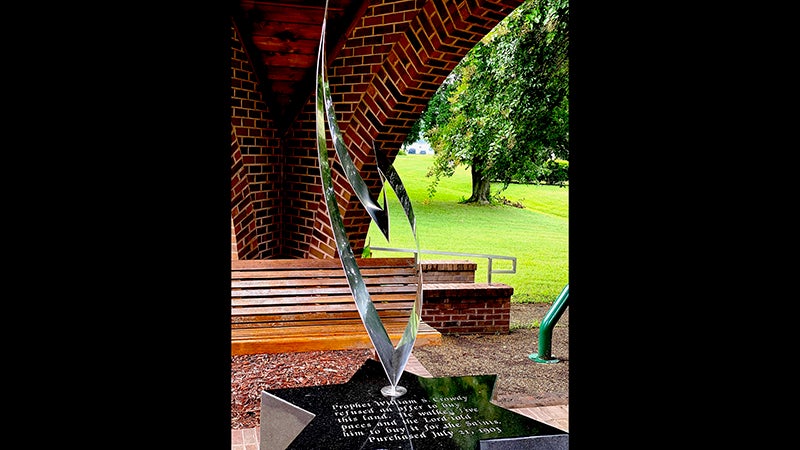Historical marker approved for Belleville community
Published 5:07 pm Tuesday, July 18, 2023

- This marker honors the memory of William Saunders Crowdy and stands at the site where he had the vision for what led to the creation of the Church of God and Saints of Christ and Suffolk's Belleville Community.
|
Getting your Trinity Audio player ready...
|
The Virginia Department of Historical Resources approved seven new historical markers, including one in Suffolk, dedicated to preserving and honoring various figures of diversity at its June 15 meeting.
Suffolk’s marker will be located in the Belleville community, in the city’s northern sector of Suffolk near the intersection of Bridge and Townpoint roads. It was initiated and sponsored by the Church of God and Saints of Christ/Temple Beth El to honor William Saunders Crowdy, whose purchase of a 40-acre site there in 1903 led to the establishment of Belleville and the church.
“The Church of God and Saints of Christ/Temple Beth El initiated this project by applying for a marker, and the Virginia Board of Historic Resources approved the topic and text,” Virginia Highway Marker Program Manager Jennifer Loux said. “The project’s goal is to educate the public about the origins of the Church of God and Saints of Christ and the history of Belleville, subjects of national-level significance about which many people might not know.”
Crowdy, an ex-slave had the vision to provide a safe haven for anyone who embraced God’s way of life. Prior to Crowdy’s purchase, four acres of the land known to be a site where Black slaves were bought and sold.
“The actual spot on the four-acre plot where slaves were auctioned has been identified, and it remains vacant today as a solitude reminder of dark days gone by,” according to the document filed in support of the historical marker. This ground then became the congregation’s sacred ground.
“In 1924, a modest structure, a tabernacle of worship was built by members of the congregation on a central section of the four-acre site, and it is still standing today,” according to the document.
Within 18 years, Crowdy’s vision gave rise to the creation of a little “city within a city,” known as Belleville.
“As was true of the biblical prophets, Crowdy taught a reverence for God while working tirelessly to alleviate human suffering,” the historical marker application states. “This man of God’s prophetic revelation had a healing effect on the spiritual wounds of both Blacks, Whites, and the indigenous people of our country. His multi-cultural mission saved and enhanced the lives of so many despite the fact at that time Blacks were considered less than human.”
It explains that Native Americans were counted among the member ranks as well, which is important because the land has ties to Nansemond Indians who saw their land taken under a Papal degree in 1493.
To provide support for Crowley’s charitable endeavors, he established numerous businesses. Examples included Noah’s Ark Clothing, a restaurant, a grocery store, a coal and wood yard, a print shop and a barber shop, the document explains.
“Belleville later expanded and became self-sufficient, with its own electric plant, stores, and many other facilities. The subject was chosen for a marker because of its broad importance as the international headquarters of a religious community that is active in the U.S., Jamaica, and Africa,” Loux said. “This is our first marker about a predominantly African American Judaic community in Virginia, so it has a high potential to educate the public.”
Along with the Belleville marker, the Department of Historic Resources approved six others tied to Black history in Virginia. They are: Luther H. Foster High School in Nottoway County, Lucyville in Cumberland County, Washington Park Community in Richmond, one honoring Stephen Bates in Charles City County, one for Arthur Crudup in Northampton County and Richmond’s First Municipal African Cemetery in the state capitol.
She said it will take eight to 12 months to get the marker in Suffolk and the other locations manufactured and installed.
“Markers are intended to educate people about significant developments in Virginia’s rich and diverse history and perhaps lead them to think in new ways about Virginia’s past,” said Loux.
Proposed text for the marker:
“William Saunders Crowdy (1847-1908), who escaped enslavement during the Civil War, established the Church of God and Saints of Christ, a now predominantly African American Judaic community, in Kansas in 1896. He purchased 40 acres here in 1903 that later formed the nucleus of Belleville, which emerged in the 1920s. Expanding to more than 700 acres at its peak, this self-sufficient community featured a sacred tabernacle, farms, a school, a home for widows and orphans, stores, an electric plant, a music hall, and athletic facilities. In 1919 the site became the international headquarters of the Church of God and Saints of Christ, which has members and missions in the U.S., Jamaica, and Africa.”




